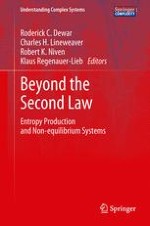2014 | OriginalPaper | Buchkapitel
21. Maximum Entropy Production by Technology
verfasst von : Peter K. Haff
Erschienen in: Beyond the Second Law
Verlag: Springer Berlin Heidelberg
Aktivieren Sie unsere intelligente Suche, um passende Fachinhalte oder Patente zu finden.
Wählen Sie Textabschnitte aus um mit Künstlicher Intelligenz passenden Patente zu finden. powered by
Markieren Sie Textabschnitte, um KI-gestützt weitere passende Inhalte zu finden. powered by
